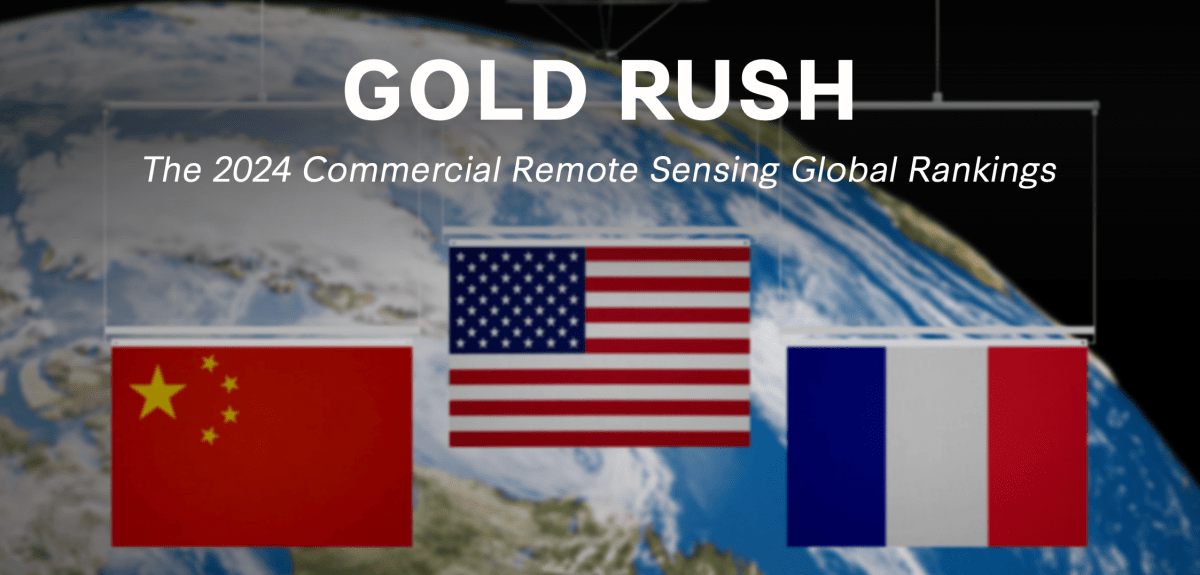WASHINGTON — A new report by a group of national security think tanks sheds light on the rapidly evolving global commercial remote sensing industry and delves into the heated competition between the United States and China.
Titled “Gold Rush: The 2024 Commercial Remote Sensing Global Rankings,” the report was published Oct. 1 by the Center for Strategic and International Studies (CSIS), Taylor Geospatial Institute, Taylor Geospatial Engine, and the U.S. Geospatial Intelligence Foundation (USGIF). It ranks the world’s best commercial space-based remote sensing systems across several performance categories, providing critical insights into the state of the industry.
While the U.S. remains a top player in the space race, China has made significant strides, the report says. Chinese systems took gold in five of 11 categories, compared to four golds for the U.S. Other nations, including Finland and South Korea, also secured podium finishes, highlighting the global competition.
The report serves as an update to the 2021 “Commercial Imaging Olympics” study conducted by the U.S. National Geospatial-Intelligence Agency. This year’s edition reflects a more dynamic landscape, with nearly half of the top-performing satellite systems being launched between 2021 and 2024.
The report ranks commercial systems across key modalities of satellite remote sensing, including electro-optical (EO), synthetic aperture radar (SAR) and multispectral, hyperspectral and infrared imagery.
EO refers to the use of visible and infrared light to capture high-resolution imagery from space. This technology allows satellites to generate images that look similar to photographs taken by cameras.
SAR differs from traditional optical methods by using radar signals to create images, enabling satellites to capture data regardless of weather conditions or light availability.
Multispectral imagery involves capturing data across different wavelengths of light, including visible and infrared, to create images that reveal more than what the human eye can see.
Hyperspectrall imaging allows for the identification of materials based on their unique spectral signatures.
Infrared imagery focuses on the thermal properties of objects and surfaces.Credit: CSISIn the EO systems category, China claimed the gold with its SuperView Neo-1 system, launched in 2022. Known for combining high-resolution imagery with a large constellation capacity, SuperView Neo-1 outperformed the competition by offering significant data collection capabilities. Although the U.S. company Maxar’s WorldView-3 system, launched in 2014, remains competitive. The report notes that Maxar’s capabilities will vastly improve with the deployment of the next-generation WorldView Legion constellation, which began launching in 2024.
The report highlights that with many commercial systems now offering native 30-centimeter resolution imagery, market differentiation increasingly relies on collection capacity and advanced data processing.
U.S. leads in SAR, but faces challengesThe SAR category saw a major shakeup, with the U.S. securing two out of three podium spots. Umbra SAR took the gold, followed by Capella Space with silver. Finnish company Iceye earned bronze. According to the report, SAR imaging is one of the most technically complex categories to assess, with Chinese systems lagging in the X-band SAR segment but leading in C-band SAR, which is valuable for environmental monitoring over large areas.
The U.S.’s dominance in SAR imaging follows a series of regulatory moves by the U.S. government. The report points to reforms led by the National Oceanic and Atmospheric Administration, which loosened restrictions on X-band SAR data sales, opening the door for U.S. companies to surge ahead.
Multispectral: Tight competitionIn the multispectral category, China came out ahead with its SuperView Neo-3 system taking gold. However, the report notes that the competition was particularly fierce in this category, with the top three systems offering nearly identical capabilities. In second place was the U.S.-Uruguayan firm Satellogic.
A key development since the 2021 NGA assessment is the emergence of competitive hyperspectral imaging systems, which capture data in hundreds of narrow spectral bands, enabling unprecedented environmental and mineral exploration. The U.S. system GHOSt, developed by Orbital Sidekick, earned gold in this category, and India’s Pixxel earned the silver medal.
Policy implications for the U.S.The report raises high-level questions about the future of U.S. leadership in commercial remote sensing. While the United States continues to excel in SAR and has made advances in hyperspectral imaging, it must keep pace with China’s rapid development in EO and multispectral technologies, the report says. It notes that recent U.S. regulatory changes have benefited domestic companies, but additional steps are needed to ensure continued global competitiveness.
As commercial space venture investments slow down in North America, the report calls on the U.S. government, particularly the intelligence community and U.S. Space Force, to increase their purchases of commercial remote sensing data. Without stronger market support from government buyers, the report insists, U.S. firms may struggle to keep up with foreign competitors in the coming years.
